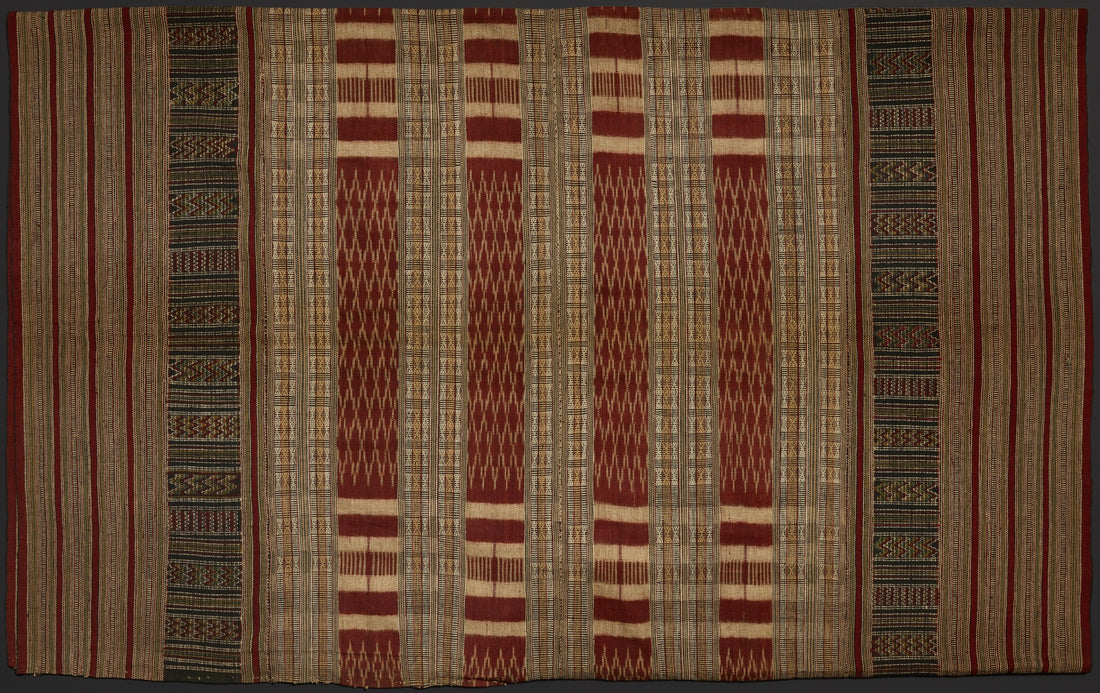
Burma to Myanmar
There are political difficulties in calling Burma, Myanmar and vice versa as Myanmar is the name given to the country by the generals currently in charge. This year the country marks 75 years of independence from British Colonial Rule and the British Museum exhibition, Burma to Myanmar sets out to examine its history and how that has shaped the country’s present day realities. 
Image: Hta-mein, women's skirt. Image above: A woman's skirt (cotton); ikat stripes. © The Trustees of the British Museum
Rich in natural resources such as jade, rubies and teak but with much of the country now living below the poverty line, Myanmar is interconnected yet cut-off. Once an influential superpower, it is now governed by a repressive regime with human rights issues including the violent persecution of the Rohingya. When the exhibition was first planned, loans from the country were anticipated, but the generals put pay to that. The many extraordinary items on display come from the BM and also many local British museums, whose collections demonstrate the importance of the country for Britain during colonial times. Intriguingly, “many objects in different collections were very similar,” according to curator Alexandra Green, apparently “bought from a 1903 mail order catalogue produced by an Italian.” The objects show how Burmese artists adapted their wares for a new European clientele.
The show includes over 130 unique exhibits, divided into four sections: an abundance of riches – geography and natural resources, a landscape of states and networks, the British colonial take-over, and the independence era. It seeks to show that historically the country wasn’t a single Kingdom and had and still has, enormous diversity ethnically and geographically.

Image: skirt cloth. © The Trustees of the British Museum
Beginning at around AD 450, the exhibition explores how the peoples of the region that is now modern Myanmar interacted with each other and the world around them, leading to the development of new ideas and art forms. The focus of the exhibition is on the 15th to 19th centuries when several kingdoms jostled for power over resources, people and religious authority and expanded their links with Thailand, China, Sri Lanka, and traders from the Middle East and Europe, creating a fertile ground for diverse cultures to flourish.
Cultural diversity, (the major theme of the show), is something the British often entirely misunderstood, heaping together very different cultural and ethnic groups. Their capacity to misunderstand is brilliantly demonstrated in a strip of brilliant ruffled gold, edged with rubies, a letter from King Alaungpaya of Burma in the 1750’s, to George 11. He mistook it for an artwork, and consigned it to a museum, leaving Alaungpaya grossly insulted by the lack of response to his magnificent epistle. Another impressive missive is the 1907 shell “letter” written to the colonial government from the townspeople of Myeik (Mergui), requesting the development of local infrastructure. The letter is written on pages of silk bound in a large shell. 
Image: Sleeveless jacket (embroidered) made of textile (cotton), seeds (coix), wool. © The Trustees of the British Museum
Textiles on display manifest the diverse nature of the country, as well as the migration both forced and voluntary of different ethnic communities. Southeast Asia was historically underpopulated and in 1767 when Myanmar's armies marched into Northern Thailand, they forcibly moved tens of thousands of Thais to Myanmar. Thai theatre troupes who were compulsorily relocated, became enormously popular in Myanmar, so much so that the Burmese court adapted Thai theatrical costumes into a new type of formal court dress (on loan from the V&A, ) exemplified by the swags on the Queen's robe, and the colour on the military robe. Thai theatre troupes often performed the ancient Indian epic, the Ramayana, which is evidenced in a magnificent embroidered wall hanging which would have hung from the eaves, illustrating scenes from the Ramayana.
A ceremonial Chin blanket, woven by the wives of high ranking men and worn by their husbands, illustrates early trading patterns. Cotton from Burma was exported to India from an early date; the BM’s example is decorated with patterns in Chinese silk. It demonstrates that diversity was common place and that a focus on a Buddhist majority would be inaccurate. 
Image: Textile hanging (detail) with scenes from the Ramayana, Myanmar, early 1900s. © 2023 The Trustees of the British Museum.
Karen textiles such as a man’s blanket also show international trade. Analysis by the BM’s science department has revealed that synthetic European dyes were in use early in the 19th century in extremely remote areas of the country.
There are wonderful woven blankets such as the late 19th or early 20th century blanket from the Nung-Rawang people (one of the Kachin groups) of northern Myanmar. Its materials, patterning and weaving techniques demonstrate both the Nung-Rawang’s links with other Kachin groups, as well as their distinct cultural attributes. 
Image: Shan Map, c.1889. Reproduced by kind permission of the Syndics of Cambridge University Library.
Burma was occupied by the Japanese during World war 11; a very detailed map drawn on a silk hankie intended for British personnel who were seeking to escape Burma after the Japanese invasion is a poignant reminder. British rule waned after the Second World War, ending in Independence in 1948.
The exhibition is a treasure trove of exquisite items, from ornate carvings to a painting of a car converted into a tank. The show is however slightly confusing, as much because of the unfamiliarity of the subject matter as because of curatorial decisions. It is a brave exhibition for the British Museum to mount in the current political climate in Myanmar and one that offers an insight into a relatively unknown world.
Text by Corinne Julius
Burma to Myanmar is on display at the British Museum until 11 February 2024.
Find out more and plan your visit:
www.britishmuseum.org/exhibitions/burma-myanmar
